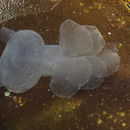Look Alikes
provided by Invertebrates of the Salish Sea
How to Distinguish from Similar Species: This is the only local Dendronotacean with a huge oral hood
- license
- cc-by-nc-sa
- copyright
- Rosario Beach Marine Laboratory
Comprehensive Description
provided by Invertebrates of the Salish Sea
As with other Dendronotacean nudibranchs, Melibe leonina has a dorsum with outgrowths in addition to rhinophores, and the clavus of the rhinophores is fully or partly retractile into its sheath. The anus is on the right side. Melibe leonina has 4-6 pairs of large, leaflike or paddlelike cerata in two rows down its dorsum and a large oral hood with two rows of filiform tentacles around its margin. The rhinophores on the oral hood are small and earlike, and have small sail-like extensions on their medial sides. Color a translucent gray, greenish-gray, or yellowish-gray, with opaque brown hepatic diverticula.
- license
- cc-by-nc-sa
- copyright
- Rosario Beach Marine Laboratory
Distribution
provided by Invertebrates of the Salish Sea
Geographical Range: Kodiak Island, Alaska to Gulf of California, Mexico. Mostly offshore in kelp beds south of Puget Sound
- license
- cc-by-nc-sa
- copyright
- Rosario Beach Marine Laboratory
Habitat
provided by Invertebrates of the Salish Sea
Depth Range: Low intertidal to 37 m
- license
- cc-by-nc-sa
- copyright
- Rosario Beach Marine Laboratory
Comprehensive Description
provided by Invertebrates of the Salish Sea
Biology/Natural History: This nudibranch is unusual in several ways. It lacks a radula, but its oral veil is expanded hugely into a hood which it extends ahead of itself and uses to trap small crustaceans and other prey. Its diet includes copepods, amphipods, and ostracods, as well as small post-larval mollusks. The animal stands attached to the substrate and expands the oral hood. It then sweeps the hood left and right or downward. When the ventral surface of the hood contacts a small animal the hood rapidly closes and the fringing tentacles overlap, holding the prey in. The whole animal is then forced into the nudibranch's mouth. Predators include the kelp crab Pugettia producta. Pycnopodia helianthoides is repelled from contact. The polychaete scaleworm Halosydna brevisetosa is sometimes a symbiont, feeding on fecal pellets. Some may have symbiotic algae. Branches of the gut extend out into the cerata. The name is due to the large hood which may look like a lion's mane. This species hunts mainly attached, but is a good swimmer. When swimming it is usually upside-down, and thrashes or undulates back and forth. It is often seen swimming near the water's surface in the summer, or after fall and winter storms disturb the eelgrass. Eggs are laid in long, wide yellow or cream-colored ribbons in the summer, which are attached to kelp and eelgrass. The ribbons form tight coils or wavy folds. Eggs can be found in the Washington area at any season. They appear to live about one year, reciprocally fertilize one another, lay their eggs and die. This species has been used for neurological research. According to Baltzley et al.,, many gastropods, including this species, have a special network of pedal ganglia in their foot which assists in crawling. The two main neurons involved produce pedal peptides which elicit an increase in the rate of beating of cilia on the foot, resulting in crawling.
- license
- cc-by-nc-sa
- copyright
- Rosario Beach Marine Laboratory
Habitat
provided by Invertebrates of the Salish Sea
Eelgrass beds, kelp beds, harbors
- license
- cc-by-nc-sa
- copyright
- Rosario Beach Marine Laboratory

